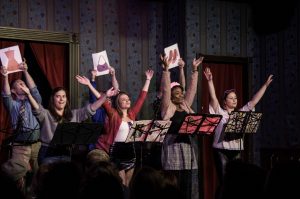Lorraine Hansberry’s 1959 play, A Raisin in the Sun concludes with the African American family leaving their bleak South Side Chicago apartment for a house in a all white neighborhood of Clybourne Park. But there is more to the historical fiction story.
What about the white couple moving away? What is their story? Playwright Bruce Norris takes those questions and answers them. His play, Clybourne Park, which won the 2011 Pulitzer Prize and is currently at the Steppenwolf Theater in Chicago.
In two afternoons, 50 years apart a house in Chicago’s northwest side becomes a site of sensitive issues of race. A 1959 middle-aged white couple is moving to the suburbs and they unknowingly sell their home to the first black family in the neighborhood, which a ignites a conflict in the community-wide.
Five decades later, the neighborhood is on the verge of gentrification and a yuppie white couple plans for demolition but have conflicts with their black neighbors.
The play opens with old rendition of the song Catch a Falling Star, which sets the 1950s time frame. Act One starts with Bev Younger packing up her belongings while Russ Younger eats ice cream out of the carton and listening to the radio. The couple banters about geography and where the name Neapolitan originated. The chemistry between Bev, (Kirsten Fitzgerald) and Russ (John Judd) is extremely relatable and real. Bev is an excitable overly eccentric housewife and Russ an awfully stubborn but loving husband. Francine, their black maid, is extremely soft-spoken and nervous.
The first act establishes the changes that were taking place in white neighborhoods at that time. Karl, a neighbor of the Youngers, represents the fear of property values going down and white flight. Karl (Cliff Chamberlain) tries to convince the Youngers that a black family wouldn’t fit in their neighborhood and that black families belong in black neighborhoods. Chamberlain brings the fear of white flight to life by passionately trying to make the audience believe that one black family could change everything.
After intermission, we revisit the house in 2009. White flight and five decades have taken their toll on the the house, making it look like dump with graffiti scrawled on the walls and garbage on the floor. In this scene the young yuppie owners and their lawyer meet with a upper-middle class black couple and lawyer representing a community preservation group.
The formula from the Act one reappears. The dialogue starts with banter about geography, neighborhoods, and small talk before it leads into the topic of race. Though the topics of conversations are almost the parallel, it seems like racism has become more complicated over time.
In Act Two, the characters are more educated and just tiptoe over the issue of race. Amy Norton directed the play as a socially charged but sprinkled comedy, aiming to make it more light-hearted.
Related articles
- Clybourne Park gets its Chicago premiere (chicagoreader.com)
- ArtsBeat Blog: ‘Clybourne Park’ Eyes Broadway (artsbeat.blogs.nytimes.com)











Be First to Comment